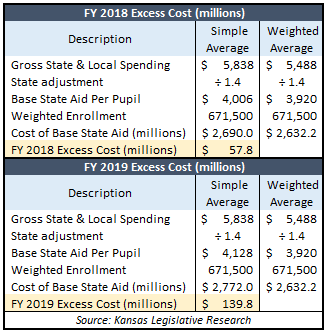Like students attempting to explain away a bad grade, school districts’ taxpayer-funded lawyers bombarded the State Supreme Court with a litany of excuses and rationalizations to justify their demand for another $972 million over the next two years. Their June 30 brief to the Court says the Legislature’s increase of $195 million in the coming school year should be pushed to $567 million and the planned increase of $293 million (over current spending) should jump to $893 million for the following year.
In other words, schools think the $1.2 billion income tax hike just foisted on citizens isn’t near enough; they’d like to see it almost doubled.
The Test Wasn’t Fair
The Court says adequacy is met when funding is reasonably calculated so students can meet or exceed certain outcomes (the Rose standards). In arguing the Legislature’s new formula doesn’t meet that test, the school lawyers trot out a version of Teenager Excuse #4 – ‘the test wasn’t fair.’ They point to no mathematical errors or logical flaws in the Legislature’s methodology to calculate funding (did the dog eat their homework?); their entire argument is that the Legislature didn’t fulfill the schools Christmas Wish List.
The lawyers say legislators had the audacity to ignore “…the recommendations of several expert bodies as to the actual costs of providing a constitutional education.” The primary ‘expert’ they referenced was the State Board of Education, which is laughably the source of their $972 million dollar demand. You see, the State Board didn’t ‘reasonably calculate’ a thing; they plucked they numbers out of thin air during a brief discussion at the July 2016 board meeting.
Yeah, But I Know Somebody Who Agrees With Me
Just as teenagers are wont to rebut facts and logic with the ironclad opinion of another teenager, the lawyers attempt to distract the Court with logical fallacies. Legislative Post Audit didn’t recommend any funding levels as claimed in the brief. On page 2, LPA clearly says their study wasn’t “…intended to dictate any specific funding level, and shouldn’t be viewed that way.”
The Legislature didn’t arrive at an independent “recommendation” to increase funding following the Montoy court order to do so; they acquiesced to a ‘pony-up-or-we’ll-close-schools’ gun to their heads.
Augenblick & Myers did recommend higher funding levels but they also admitted that they ignored their own methodology to produce inflated numbers. They were supposed to identify academically successful school districts and base their funding recommendations on the subset of those districts that were efficient operators; instead, they threw efficiency out the window. Essentially, they said some other kids may have gotten better grades because their parents bought them a more expensive computer…so Mom and Dad, my bad grade is really your fault.
Subsequently aware of the inflated A&M numbers, the Gannon Supreme Court changed the rules for determining adequacy and instructed the lower court that the A&M cost study was “…more akin to estimates than the certainties…” they envisioned. The lawyers and schools know the rules have changed but they still want to stomp their feet and hope sympathetic grandparents will let them make up new rules at whim.
Reasonably Calculated Saves at least $161 Million
Technically, they’re right about one thing – the $293 million increase passed by the Legislature isn’t the result of a reasonable calculation of funding to achieve the Rose standards. A math error discovered in HB 2410 was knowingly carried over to SB 19 (the final vehicle for the school funding formula), so the reasonably calculated funding increase would be about $161 million less over two years (and still more than necessary for efficiency reasons).
 Using a simple average (basically, an average of averages) instead of a weighted average results in FY 2018 being $57.8 million too high. FY 2019 is $139.8 million more than the formula actually calculates but the reasonably calculated base of $3,920 per-pupil for FY 2019 should be increased for inflation of about 1.4 percent at a cost of about $37 million.
Using a simple average (basically, an average of averages) instead of a weighted average results in FY 2018 being $57.8 million too high. FY 2019 is $139.8 million more than the formula actually calculates but the reasonably calculated base of $3,920 per-pupil for FY 2019 should be increased for inflation of about 1.4 percent at a cost of about $37 million.
The $198 million math error less a $37 million inflation bump means taxpayers are providing at least $161 million more than needs be reasonably provided.
The ‘at least’ qualifier refers to the fact that the new formula doesn’t take efficient use of taxpayers into account; funding is merely based on the actual spending of the 41 districts that were determined to be meeting the Rose standards.
So if the Court finds the new formula to not be reasonably calculated, the Legislature should fix their math error and save taxpayers $161 million…and come back next year to adjust funding for efficiency.




